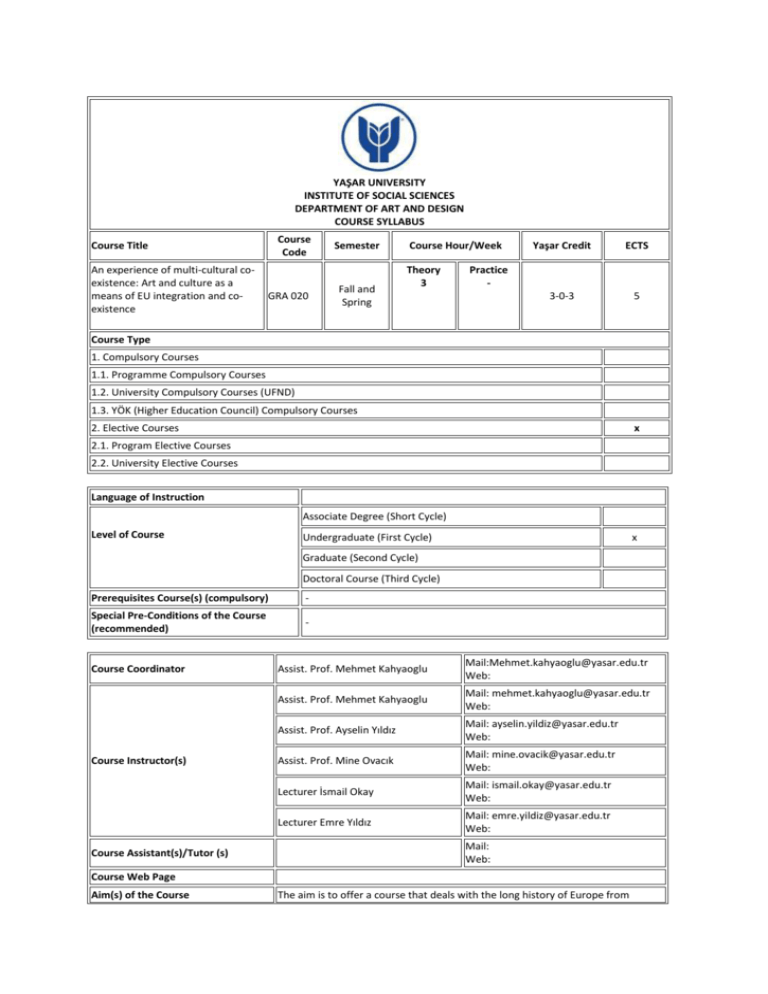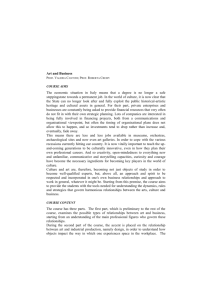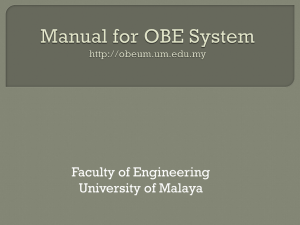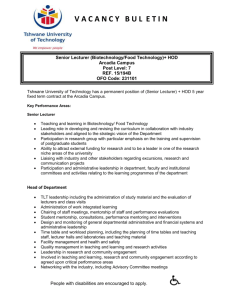GRA_020_Art and culture as a means of EU
advertisement

YAŞAR UNIVERSITY INSTITUTE OF SOCIAL SCIENCES DEPARTMENT OF ART AND DESIGN COURSE SYLLABUS Course Code Course Title An experience of multi-cultural coexistence: Art and culture as a means of EU integration and coexistence GRA 020 Semester Fall and Spring Course Hour/Week Theory 3 Yaşar Credit ECTS 3-0-3 5 Practice - Course Type 1. Compulsory Courses 1.1. Programme Compulsory Courses 1.2. University Compulsory Courses (UFND) 1.3. YÖK (Higher Education Council) Compulsory Courses 2. Elective Courses x 2.1. Program Elective Courses 2.2. University Elective Courses Language of Instruction Associate Degree (Short Cycle) Level of Course Undergraduate (First Cycle) x Graduate (Second Cycle) Doctoral Course (Third Cycle) Prerequisites Course(s) (compulsory) - Special Pre-Conditions of the Course (recommended) - Course Coordinator Course Instructor(s) Course Assistant(s)/Tutor (s) Assist. Prof. Mehmet Kahyaoglu Mail:Mehmet.kahyaoglu@yasar.edu.tr Web: Assist. Prof. Mehmet Kahyaoglu Mail: mehmet.kahyaoglu@yasar.edu.tr Web: Assist. Prof. Ayselin Yıldız Mail: ayselin.yildiz@yasar.edu.tr Web: Assist. Prof. Mine Ovacık Mail: mine.ovacik@yasar.edu.tr Web: Lecturer İsmail Okay Mail: ismail.okay@yasar.edu.tr Web: Lecturer Emre Yıldız Mail: emre.yildiz@yasar.edu.tr Web: Mail: Web: Course Web Page Aim(s) of the Course The aim is to offer a course that deals with the long history of Europe from political, cultural and artistic points of view to underline the main conflict bearing areas within Europe and how those conflicts are put aside for the motivation of the co-existence for a common future and make students aware of co-existence of various political, religious, cultural and sexual communities in Europe. Learning Outcomes of the Course Course Content 1- Record general political, cultural and artistic history of Europe. 2- List the major historical periods of Europe. 3- Describe consequences of main political events in the history of Europe reflected in art and culture. 4- Employ theoretical background into design works. 5- Distinguish main art movements and periods. 6- Create designs reflecting the main characteristics of different cultures. The course will have a distinctively different approach of general EU studies as it uses art and design as tools of understanding the multi-cultural structure of the European society within an environment of international education dynamics. The focus of the course will be the historical presentation of European cultural, political and economical dynamics and their relationship to today’s common future of EU values on which the students will be asked to participate a 3 days long workshop to produce design and art works on multi-cultural co-existence. COURSE OUTLINE/SCHEDULE (Weekly) Preliminary Preparation Week Topics Methodology and Implementation (theory,practice, assignment etc) 1 The idea of EU. What is EU and what is the motive behind? Lecturer’s notes Theory 2 The political history of Europe I From Ancient Times to the French Revolution. Lecturer’s notes Theory 3 Political history of Europe II From 1789 up until today. Lecturer’s notes Theory 4 Cultural history of Europe I Lecturer’s notes Theory 5 Cultural history of Europe II Lecturer’s notes Theory 6 Artistic history of Europe I: From Ancient Times to Renaissance Lecturer’s notes Theory 7 Artistic history of Europe II: From Baroque to Romanticism Lecturer’s notes Theory 8 Artistic history of Europe III From Modern to PostModern. Lecturer’s notes Theory 9 Mid-term 10 History of Design I Graphic elements of European Culture. Lecturer’s notes Theory 11 History of Design II Design in the age of Information Technologies Lecturer’s notes Theory 12 History of Design III Co-design practices in multicultural groups Lecturer’s notes Theory 13 Workshop: Design for co-existence (2 days) Practice 14 Evaluation and Exhibition Theory Theory Required Course Material (s) /Reading(s)/Text Book (s) Lecturers’ notes Rampley, M. (2012). Art history and visual studies in Europe transnational discourses and national frameworks. Leiden Boston: Brill. Greyerz, K. & Dunlap, T. (2008). Religion and culture in early modern Europe, 1500-1800. Oxford: Oxford University Press. Bátora, J. & Mokre, M. (2011). Culture and external relations Europe and beyond. Farnham, England Burlington, VT: Ashgate. Recommended Course Material (s)/Reading(s)/Other Fuad-Luke, A. (2009), Design Activism: Beautiful Strangeness for a Sustainable World. London: Earthscan Meroni, A. (ed.) (2007). Creative Communities, People Inventing Creative ways of Living. Milano: Edizioni POLI.Design Garfield, S. (2010). Just my type : a book about fonts. London: Profile Books. Eskilson, S. (2012). Graphic design : a new history. New Haven, Conn: Yale University Press. ASSESSMENT Semester Activities/ Studies NUMBER WEIGHT in % Mid- Term 1 30 Attendance - - Quiz - - 10 10 Project - - Laboratory - - Field Studies (Technical Visits) - - Presentation/ Seminar - - Practice (Laboratory, Virtual Court, Studio Studies etc.) - - Other (Placement/Internship etc.) - - Assignment (s) TOTAL 40 Contribution of Semester Activities/Studies to the Final Grade 40 Contribution of Final Examination/Final Project/ Dissertation to the Final Grade 60 TOTAL . 100 CONTRIBUTION OF LEARNING OUTCOMES TO PROGRAMME OUTCOMES No Programme Outcomes Level of Contribution (1lowest/ 5highest) 1 2 3 4 5 1 To produce innovative designs for solution of visual problems as employing the acquired historical and critical theoretical background x 2 To produce creative results as analyzing the Western and the other cultures’ design products in comparison with the local culture, allocating projects and developing awareness raising x 3 To develop conceptual methods by discovering the design elements and principles instead of memorizing them 4 To demonstrate visual literacy through identification of the conceptual approaches for determining and solving problems in design production x x To demonstrate the knowledge and use the technological proficiency (computer softwares) for 5 being able to follow the technical developments in the field and realize the projects in response to the needs of the clients throughout the entire business life 6 To produce creative results regarding visual production as developing distinctive digital and traditional visuals in different media and techniques 7 To perceive and associate all the fields that take place in graphic design, use them appropriately for visual problem solving - x x x 8 To conduct projects and conclude them on time as individually or as a group member 9 x To produce an interdisciplinary portfolio through the assessment of all the projects that realized during the undergraduate education and with the acquired presentation skills x 10 To adopt and employ the graphic design business ethics throughout the entire business life x ECTS /STUDENT WORKLOAD NUMBER UNIT HOUR TOTAL (WORKLOAD) Course Teaching Hour (14 weeks* total course hours) 14 week 3 42 Preliminary Preparation and finalizing of course notes, further self- study 14 week 2 28 Assignment (s) 10 quantity 2 20 1 quantity 8 8 1 quantity 26 26 ACTIVITIES Presentation/ Seminars Quiz and Preparation for the Quiz Mid- Term(s) Project (s) Field Studies (Technical Visits, Investigate Visit etc.) Practice (Laboratory, Virtual Court, Studio Studies etc.) Final Examination/ Final Project/ Dissertation and Preparation Other (Placement/Internship etc.) Total Workload 124 Total Workload/ 25 25 ECTS 5 ETHICAL RULES WITH REGARD TO THE COURSE (IF AVAILABLE) ASSESSMENT and EVALUATION METHODS: Final Grades will be determined according to the Yaşar University Associate Degree, Bachelor Degree and Graduate Degree Education and Examination Regulation PREPARED BY Assist. Prof. Mehmet Kahyaoğlu UPDATED 06. 08. 2015, 15:45 APPROVED







